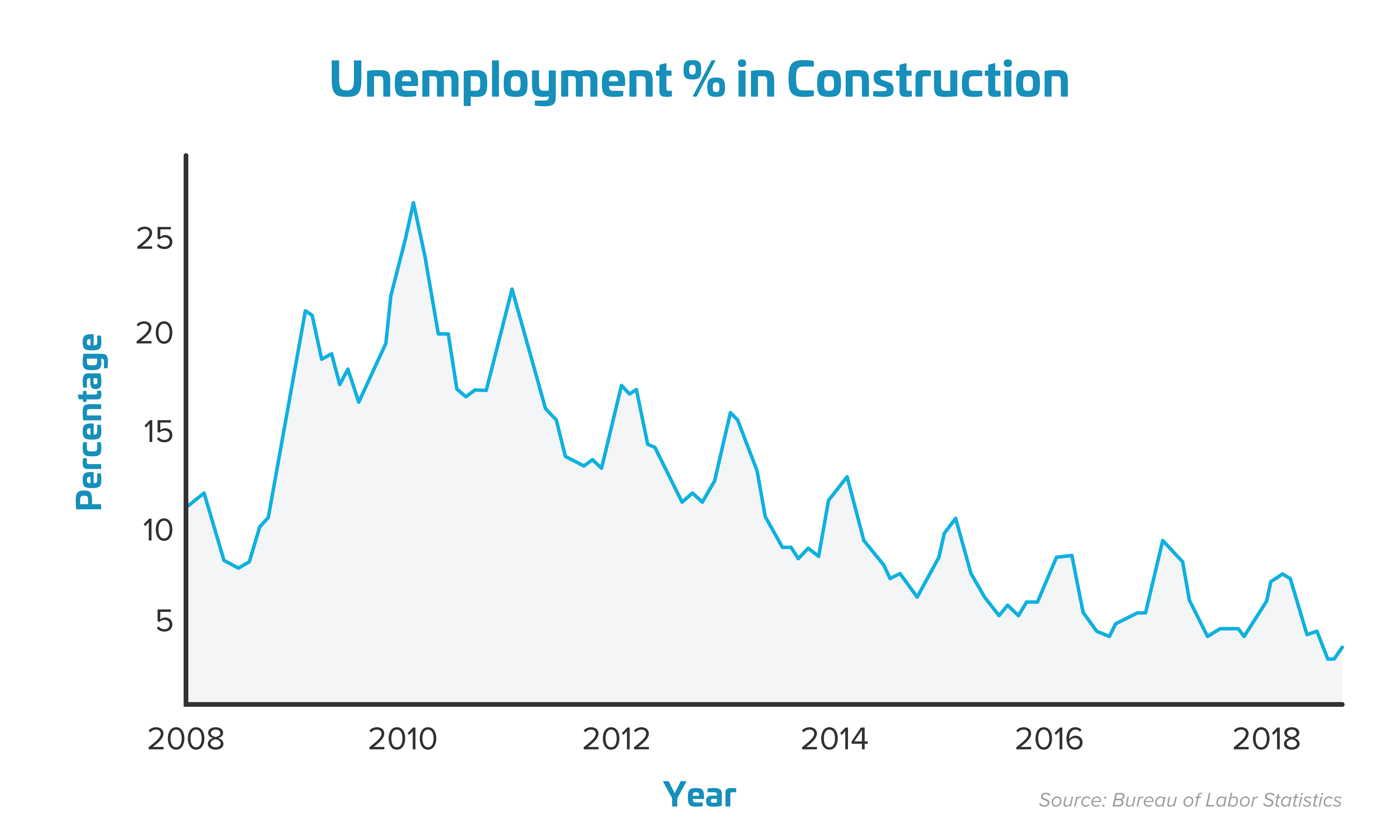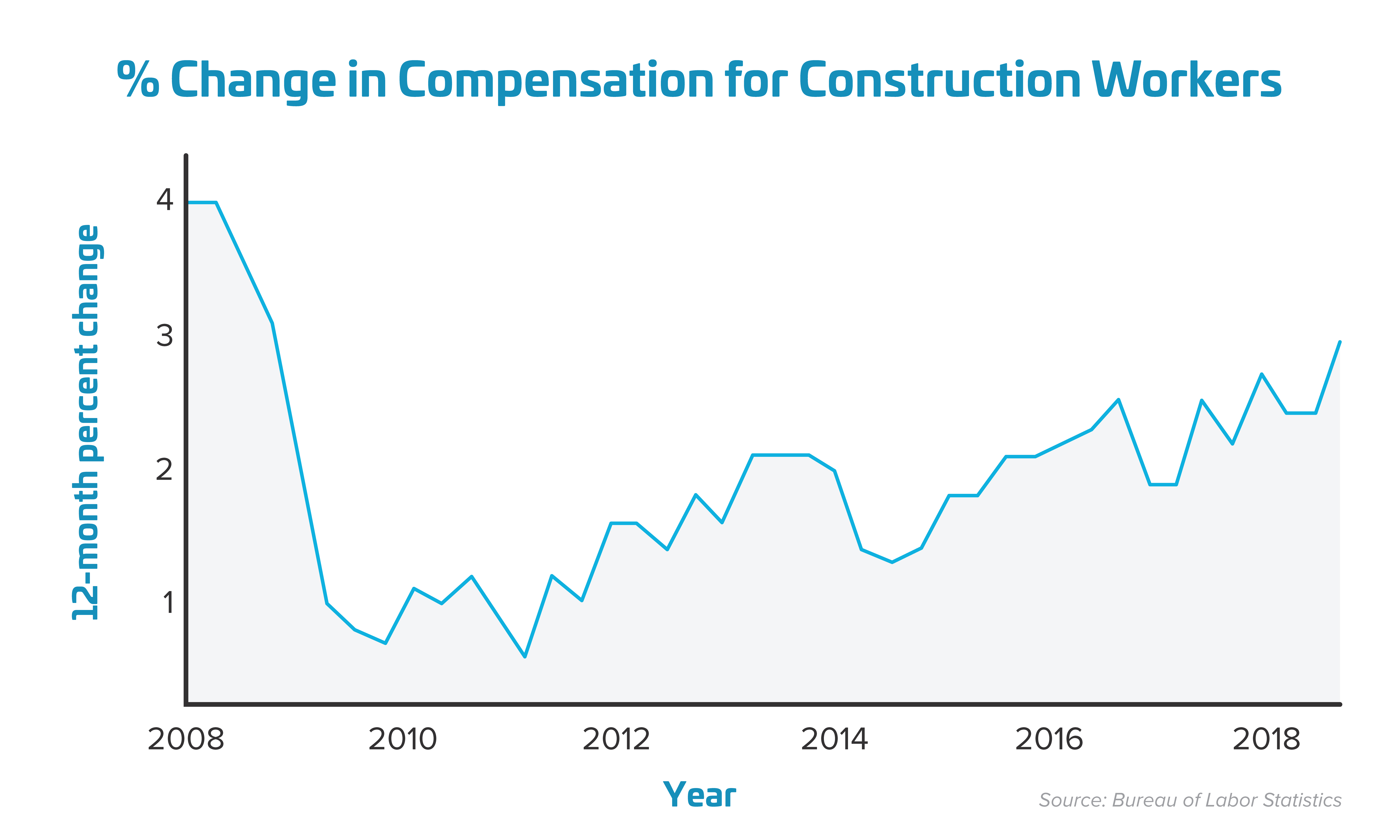
2018 marked a major milestone for the US construction industry. According to the census bureau, after sinking to a 2011 low of $755 million, construction spending in the United States last August rose to a $1.3 trillion annual pace, eclipsing the pre-recession high of $1.162 trillion , bolstering the profitability of the sector’s players and leading to optimistic about a continued climb.
Amidst the cheering, however, there is also growing concern. The construction industry is facing an acute, looming labor shortage. According to the Bureau of Labor Statistics , the construction industry hit 7.2 million jobs in June of 2018, nearly reaching the pre-recession high of 7.5 million workers. Unfortunately, the industry also lost nearly 2 million jobs in the last recession, and many of those people never returned to the workforce. Now the built world is in the process of absorbing 2 million people who have entered the construction market since 2011, many of whom are new to the industry and lack the skills and experience needed to achieve expected levels of safety, productivity, and quality.

In July of 2018, the unemployment rate for construction workers sunk to what may be an all-time low of 3.4%.
We simply are running out of people to employ.
Meantime, with demand outstripping supply, the number of job openings continues to climb. From a low of just 50,000 job openings in the depths of the recession, the industry is now looking to fill more than 250,000 jobs.

Unable to fill the positions they need to service the projects they have booked, contractors are increasing wages at an accelerating pace, as they compete to attract workers, most of whom are already working.


Given this mix of record low unemployment and increasing demand for workers, wage rates seem bound to continue to escalate, affecting project budgets, and leading to increasing calls for solutions.
The industry is mounting numerous initiatives aimed at recruiting more talent into the workforce. But barring that, a long-awaited increase in productivity appears to be the only way to enable the industry to put more work in place. While the industry had been widely criticized for failures to post significant--or possibly any--productivity gains in recent decades and onslaught of investment in new technology seems set to create new opportunities to tip the industry’s productivity scales.
Below are six themes around which emerging technology companies are potentially helping enhance worker productivity and address the industry’s labor shortage challenges:
- Modularization and Pre-Assembly - From Softbank’s well-publicized investment in Katerra to a host of smaller initiatives by companies like Blox, Blockable, ManufactOn, Prescient, and Full Stack Modular, are also dedicated to helping the industry build more of projects off-site in controlled environments where it is easier to leverage machinery, train and oversee the workforce, and improve productivity by driving out the variability of weather and differing site conditions.
- Robotics and Advanced Construction Equipment - Construction Robotics, Falcon Brick, Skyline Robotics, and Tybot are all examples of companies developing machinery that can perform difficult, dirty, and time consuming tasks currently carried out by humans. Whether it is the wear and tear of laying heavy bricks, bending and tying rebar in roadwork, or lifting and installing bulky drywall panels, robots now promise to help people get more work done and also to extend their careers, by reducing injuries and also by reducing the physical demands of construction work.
- Communications/Workflow Management - According to an August 2018 study by construction industry consulting firm, FMI, commissioned by industry software player, PlanGrid, construction workers waste approximately 35% of their work week on non-value-adding activities such as “looking for project data.” Workflow technology companies, such as PlanGrid, and dozens of other specialized project management software solutions promise to improve the speed and accuracy of jobsite communications, helping avoid costly delays and rework.
- AI and Machine Learning in Planning Software - The same study pointed to conflict resolution, and rework and dealing with mistakes as two other major factors in lack of productivity on the jobsite. Advances in planning tools by companies like Parafin, ALICE, and OnTarget are examples of emerging technology players helping companies improve their planning efforts, leveraging AI and Machine Learning to help construction companies consider more scenarios and develop better approaches to their work plans.
- A/R, V/R, Mixed Reality Devices for Training Purposes - While companies like Serious Labs and worksiteVR are developing tools to help workers better visualize and understand their work in the field before they go to work, other companies like XOi and ScopeAR focus on getting knowledge and expertise to workers in the field in real time.
- IoT Driven Improvements in Site Monitoring/Management - Whether it is labor tracking with companies like Rumbix and Busy Busy, equipment and materials tracking from players like Tenna and drone companies like Uplift and SiteSware, laser scanners like Skur and FARO, or camera systems like OxBlue and Sensera, the “office” has more ability than ever to monitor what is happening on the jobsite and adjust more quickly or provide guidance remotely to keep people working productively.
Most of these technologies are still fairly early in their development and implementation. So, it remains to be seen what impact they will have on the industry and whether the construction industry is finally on the verge of significant leaps in productivity similar to what has been witnessed in agriculture and manufacturing. Certainly impediments remain, but the advent of cheaper, mobile-friendly, and more relevant solutions seems to offer the promise of change in a scale not previously seen.




Discussion
Be the first to leave a comment.
You must be a member of the BuiltWorlds community to join the discussion.